Datura
Datura is a genus of nine species of poisonous Vespertine flowering plants belonging to the family Solanaceae. They are commonly known as daturas, but also known as devil's trumpets[1] (not to be confused with angel's trumpets, its closely related genus Brugmansia). Other English common names include moonflower, jimsonweed, devil's weed, hell's bells and thorn-apple. The Mexican common names Toloache and Tolguacha derive from the Nahuatl name Tolohuaxihuitl meaning "the plant with the nodding head" (in reference to the nodding seed capsules of Datura species belonging to section Dutra of the genus). Datura species are native to dry, temperate, and subtropical regions of the Americas and are distributed mostly in Mexico, which is considered the center of its origin. Although Datura ferox occurs in Argentina, Datura metel in Asia, and Datura leichardthii in Australia, these species were probably introduced from Mexico.[2] Its distribution within the Americas and North Africa, however, is most likely restricted to the United States, Mexico and Southern Canada in North America, and Tunisia in Africa where the highest species diversity occurs.
| Datura | |
|---|---|
 | |
| Datura metel | |
| Scientific classification | |
| Kingdom: | Plantae |
| Clade: | Tracheophytes |
| Clade: | Angiosperms |
| Clade: | Eudicots |
| Clade: | Asterids |
| Order: | Solanales |
| Family: | Solanaceae |
| Subfamily: | Solanoideae |
| Tribe: | Datureae |
| Genus: | Datura L. |
| Type species | |
| Datura stramonium L. | |
| Species | |
|
See text | |
All species of Datura are poisonous, especially their seeds and flowers which can cause respiratory depression, arrhythmias, hallucinations, psychosis, as well as death if taken internally.
A group of South American species formerly placed in the genus Datura are now placed in the distinct genus Brugmansia[3] (Brugmansia differs from Datura in that it is woody, making shrubs or small trees, and it has pendulous flowers, rather than erect ones). Other related taxa include Hyoscyamus niger, Atropa belladonna, Mandragora officinarum, Physalis, and many more.
Etymology
The name Datura is taken from Sanskrit धतूरा dhatūra 'thorn-apple',[4] ultimately from Sanskrit धत्तूर dhattūra 'white thorn-apple' (referring to Datura metel of Asia).[5] In the Ayurvedic text Sushruta Samhita different species of Datura are also referred to as kanaka and unmatta.[5] Dhatura is offered to Shiva in Hinduism. Record of this name in English dates back to 1662.[6] Nathaniel Hawthorne refers to one type in The Scarlet Letter as apple-Peru. In Mexico, its common name is toloache.
Description
Datura species are herbaceous, leafy annuals and short-lived perennials which can reach up to 2 m in height. The leaves are alternate, 10–20 cm long and 5–18 cm broad, with a lobed or toothed margin. The flowers are erect or spreading (not pendulous like those of Brugmansia), trumpet-shaped, 5–20 cm long and 4–12 cm broad at the mouth; colors vary from white to yellow, pink, and pale purple. The fruit is a spiny capsule 4–10 cm long and 2–6 cm broad, splitting open when ripe to release the numerous seeds. The seeds disperse freely over pastures, fields and even wasteland locations.
Datura belongs to the classic "witches' weeds", along with deadly nightshade, henbane, and mandrake. All parts of the plants are toxic, and datura has a long history of use for causing delirious states and death. It was well known as an essential ingredient of potions and witches' brews, most notably Datura stramonium.[7]
In India it has been referred to as "poisonous" and as an aphrodisiac. In little measures it was used in Ayurveda as a medicine from the ancient times. It is used in rituals and prayers to Shiva. It is also used in Ganesh Chaturthi.
The larvae of some Lepidoptera (butterfly and moth) species, including Hypercompe indecisa, eat some Datura species.
Species and cultivars
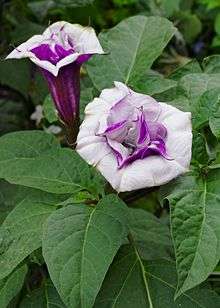
It is difficult to classify Datura as to its species, and it often happens that the descriptions of new species are accepted prematurely. Later, these "new species" are found to be simply varieties that have evolved due to conditions at a specific location. They usually disappear in a few years. Contributing to the confusion is the fact that various species, such as D. wrightii and D. inoxia, are very similar in appearance, and the variation within a species can be extreme. For example, Datura species can change size of plant, leaf, and flowers, all depending on location. The same species, when growing in a half-shady, damp location can develop into a flowering bush half as tall as an adult human of average height, but when growing in a very dry location, will only grow into a thin plant not much more than ankle-high, with tiny flowers and a few miniature leaves.[7]
Today, experts classify only nine species of Datura:[7]
| Image | Scientific name | Common Name | Distribution |
|---|---|---|---|
| D. ceratocaula Jacq. | torna loco | Mexico. | |
 | D. discolor Bernh. (syn. D. kymatocarpa, D. reburra) | desert thorn-apple | Sonoran Desert of western North America |
| D. ferox L. | long-spined thorn-apple | southeastern China | |
.jpg) | D. innoxia Mill. | thorn-apple, downy thorn-apple, Indian-apple, moonflower, sacred datura, toloatzin, toloache | Southwestern United States, Central and South America |
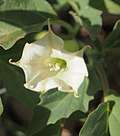 | D. leichhardtii F.Muell. ex Benth. (syn. D. pruinosa) | Leichhardt's datura | from Mexico to Guatemala |
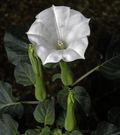 | D. metel L. | devil's trumpet[7] | Asia, Africa. |
| D. quercifolia Kunth | oak-leaf thorn-apple | Mexico and the Southwestern United States | |
| D. stramonium L. (syn. D. inermis, D. bernhardii) | jimsonweed, thorn-apple | Central America | |
 | D. wrightii Regel | sacred datura, sacred thorn-apple | southwestern North America. |
American Brugmansia and Datura Society, Inc. (ABADS) is designated in the 2004 edition of the International Code of Nomenclature for Cultivated Plants as the official International Cultivar Registration Authority for Datura. This role was delegated to ABADS by the International Society for Horticultural Science in 2002.
Past classified species
- D. lanosa
- D. suaveolens
Cultivation
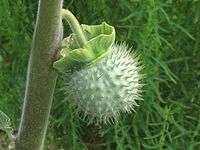
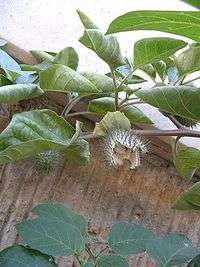
Datura species are usually sown annually from the seed produced in the spiny capsules, but, with care, the tuberous-rooted perennial species may be overwintered. Most species are suited to being planted outside or in containers. As a rule, they leed warm, sunny places and soil that will keep their roots dry. When grown outdoors in good locations, the plants tend to reseed themselves and may become invasive. In containers, they should have porous, aerated potting soil with adequate drainage. The plants are susceptible to fungi in the root area, so anaerobic organic enrichment such as anaerobically composted organic matter or manure, should be avoided.[7]
Toxicity
All Datura plants contain tropane alkaloids such as scopolamine and atropine, primarily in their seeds and flowers as well as the roots of certain species such as D. wrightii. Because of the presence of these substances, Datura has been used for centuries in some cultures as a poison.[7][8] A given plant's toxicity depends on its age, where it is growing, and the local weather conditions. These variations make Datura exceptionally hazardous as a drug.
In traditional cultures, a great deal of experience with and detailed knowledge of Datura was critical to minimize harm.[7] Many tragic incidents result from modern users ingesting Datura. For example, in the 1990s and 2000s, the United States media contained stories of adolescents and young adults dying or becoming seriously ill from intentionally ingesting Datura.[9][10] There are also several reports in the medical literature of deaths from D. stramonium and D. ferox intoxication.[11][12][13] Children are especially vulnerable to atropine poisoning.[14][15]
In some parts of Europe and India, Datura has been a popular poison for suicide and murder. From 1950 to 1965, the State Chemical Laboratories in Agra, India, investigated 2,778 deaths caused by ingesting Datura.[7][16] The Thugs (practicers of thuggee) were devotees of an Indian religious cult made up of robbers and assassins who strangled and/or poisoned their victims in rituals devoted to the Hindu goddess Kali. They were known to employ Datura in many such poisonings, using it also to induce drowsiness or stupefaction, making strangulation easier.[17]
Datura toxins may be ingested accidentally by consumption of honey produced by several wasp species, including Brachygastra lecheguana, during the Datura blooming season. It appears that these semi-domesticated honey wasps collect Datura nectar for honey production which can lead to poisoning.[18]
The US Centers for Disease Control and Prevention reported accidental poisoning resulting in hospitalization for a family of six who inadvertently ingested Datura used as an ingredient in stew.[19]
In some places, it is prohibited to buy, sell, or cultivate Datura plants.[7][16]
Effects of ingestion
Due to the potent combination of anticholinergic substances it contains, Datura intoxication typically produces effects similar to that of an anticholinergic delirium (usually involving a complete inability to differentiate reality from fantasy); hyperthermia; tachycardia; bizarre, and possibly violent behavior; and severe mydriasis (dilated pupils) with resultant painful photophobia that can last several days. Muscle stiffness, urinary retention, temporary paralysis, and confusion is often reported and pronounced amnesia is another commonly reported effect.[20]
Psychoactive use
Datura is considered a deliriant. Christian Rätsch has said "A mild dosage produces medicinal and healing effects, a moderate dosage produces aphrodisiac effects, and high dosages are used for shamanic purposes". Wade Davis (anthropologist), an ethnobotanist, lists it as a possible ingredient of zombie potion.[21]
In Pharmacology and Abuse of Cocaine, Amphetamines, Ecstasy and Related Designer Drugs, Freye asserts: Few substances have received as many severely negative recreational experience reports as has Datura. The overwhelming majority of those who describe their use of Datura find their experiences extremely unpleasant both mentally and often physically dangerous.[20] However, anthropologists have found that indigenous groups, with a great deal of experience with and detailed knowledge of Datura, have been known to use Datura spiritually (including the Navajo and especially the Havasupai).[22][23] Again, knowledge of Datura's properties is necessary to facilitate a healthy experience.[7] The Southern Paiute believe Datura can help locate missing objects.[24] In ancient Mexico, Datura also played an important role in the religion of the Aztecs and the practices of their medicine men and necromancers.[25]
Bernardino de Sahagún, in around 1569, called attention to Datura in the following words: “It is administered in potions in order to cause harm to those who are objects of hatred. Those who eat it have visions of fearful things. Magicians or those who wish to harm someone administer it in food or drink. This herb is medicinal and its seed is used as a remedy for gout, ground up and applied to the part affected.” [25]
Treatment
Due to their agitated behavior and confused mental state, victims of Datura poisoning are typically hospitalized. Gastric lavage and the administration of activated charcoal can be used to reduce the stomach's absorption of the ingested material and the drug physostigmine is used to reverse the effect of the poisons. Benzodiazepines can be given to curb the patient's agitation, and supportive care with oxygen, hydration, and symptomatic treatment is often provided. Observation of the patient is indicated until the symptoms resolve, usually from 24–36 hours after ingestion of the Datura.[16][26]
Gallery
_near_Hyderabad%2C_Andhra_Pradesh%2C_India_01.jpg) Datura flower on the plant (lateral view) near Hyderabad, Andhra Pradesh, India
Datura flower on the plant (lateral view) near Hyderabad, Andhra Pradesh, India_near_Hyderabad%2C_Andhra_Pradesh%2C_India_02.jpg) Datura flower on the plant (top view) near Hyderabad, Andhra Pradesh, India
Datura flower on the plant (top view) near Hyderabad, Andhra Pradesh, India- Datura wrightii in bloom
See also
- Donnatal, a pharmaceutical containing the active alkaloids in belladonna, a plant similar to Datura: scopolamine, hyoscyamine, and atropine, as a drug
References
- "Datura metel". plants.ces.ncsu.edu. Retrieved 17 January 2016.
- Karinho-Betancourt, Eunice; Agrawal, Anurag A.; Halitschke, Rayko; Nunez-Farf ~ an, Juan (2015). "Phylogenetic correlations among chemical and physical plant defenses change with ontogeny". New Phytologist. 206 (2): 796–806. doi:10.1111/nph.13300. PMID 25652325.
- Lester, R. N.; Nee, M.; Estrada, N. (1991). Hawkes, J. G. (ed.). Solanaceae III – Taxonomy, Chemistry, Evolution (Proceedings of Third International Conference on Solanaceae). Kew: Royal Botanic Gardens. pp. 197–210. ISBN 0-947643-31-1.
- American Heritage Dictionary: datura
- Monier-Williams, Monier (1899). A Sanskrit-English dictionary : etymologically and philologically arranged with special reference to cognate Indo-European languages. Oxford: Clarendon Press.
- the Oxford English Dictionary or OED
- Preissel, U.; Preissel, H.-G. (2002). Brugmansia and Datura: Angel's Trumpets and Thorn Apples. Buffalo, NY: Firefly Books. pp. 106–129. ISBN 1-55209-598-3.
- Adams, J. D. Jr.; Garcia, C. (2005). "Spirit, Mind and Body in Chumash Healing". Evidence-based Complementary and Alternative Medicine. 2 (4): 459–463. doi:10.1093/ecam/neh130. PMC 1297503. PMID 16322802. Archived from the original on 12 October 2007.
- Goetz, R.; Siegel, E.; Scaglione, J.; Belson, M.; Patel, M. (2003). "Suspected Moonflower Intoxication – Ohio, 2002". MMWR. Morbidity and Mortality Weekly Report. CDC. 52 (33): 788–791. PMID 12931077.
- Leinwand, D. (1 November 2006). "Jimson weed users chase high all the way to hospital". USA TODAY. Retrieved 15 February 2009.
- Michalodimitrakis, M.; Koutselinis, A. (1984). "Discussion of "Datura stramonium: A fatal poisoning"". Journal of Forensic Sciences. 29 (4): 961–962. PMID 6502123.
- Boumba, V. A.; Mitselou, A.; Vougiouklakis, T. (2004). "Fatal poisoning from ingestion of Datura stramonium seeds". Veterinary and Human Toxicology. 46 (2): 81–82. PMID 15080209.
- Steenkamp, P. A.; Harding, N. M.; Van Heerden, F. R.; Van Wyk, B.-E. (2004). "Fatal Datura poisoning: Identification of atropine and scopolamine by high performance liquid chromatography / photodiode array / mass spectrometry". Forensic Science International. 145 (1): 31–39. doi:10.1016/j.forsciint.2004.03.011. PMID 15374592.
- Taha, S. A.; Mahdi, A. H. (1984). "Datura intoxication in Riyadh". Transactions of the Royal Society of Tropical Medicine and Hygiene. 78 (1): 134–135. doi:10.1016/0035-9203(84)90196-2. PMID 6710568.
- Djibo, A.; Bouzou, S. B. (2000). "[Acute intoxication with "sobi-lobi" (Datura). Four cases in Niger]". Bulletin de la Société de Pathologie Exotique (in French). 93 (4): 294–297. PMID 11204734.
- Andrews, Dale (28 February 2013). "Daturas". Crime Poisons. Washington: SleuthSayers. Retrieved 4 March 2013.
- Dash, Mike Thug: the true story of India's murderous cult ISBN 1-86207-604-9, 2005
- Bequaert, J.Q. (1932). "The Nearctic social wasps of the subfamily polybiinae (Hymenoptera; Vespidae)". Entomologica Americana. 13 (3): 87–150.
- Bontoyan, W.; et al. (5 February 2010). "Jimsonweed Poisoning Associated with a Homemade Stew – Maryland, 2008" (PDF). Centers for Disease Control and Prevention – Morbidity and Mortality Weekly Report. 59 (4): 102–103. Retrieved 11 February 2010.
- Freye, E. (2010). "Toxicity of Datura stramonium". Pharmacology and Abuse of Cocaine, Amphetamines, Ecstasy and Related Designer Drugs. Netherlands: Springer. pp. 217–218. doi:10.1007/978-90-481-2448-0_34. ISBN 978-90-481-2447-3.
- A Dictionary of Hallucations. Oradell, NJ.: Springer. 2010. p. 127.
- Gaire, Bhakta Prasad; Subedi, Lalita (2013). "A review on the pharmacological and toxicological aspects of Datura stramonium L". Journal of Integrative Medicine. 11 (2): 73–9. doi:10.3736/jintegrmed2013016. PMID 23506688.
- Fuller, Robert C (2000). Stairways to Heaven: Drugs in American Religious History. Basic Books. p. 32. ISBN 0813366127.
- Southern Paiute Shamanism by Isabel T. Kelly (1939) http://digitalassets.lib.berkeley.edu/anthpubs/ucb/text/ucar002-005.pdf
- Safford, William (1916). Narcotic Plants and Stimulants of the Ancient Americans. United States: Economic Botanist. pp. 405–406.
- Bliss, M. (2001). "Datura Plant Poisoning" (PDF). Clinical Toxicology Review. 23 (6).
Further reading
- Rätsch, C. (2005) [1998]. The Encyclopedia of Psychoactive Plants. Rochester, VT: Park Street Press. ISBN 978-0-89281-978-2.
- Bliss, M. (2001). "Datura Plant Poisoning" (PDF). Clinical Toxicology Review. 23 (6).
- Tropane Alkaloid Poisoning on eMedicine
- Roblot, F; Montaz, L; Delcoustal, M; Gaboriau, E; Chavagnat, JJ; Morichaud, G; Pourrat, O; Scepi, M; Patte, D (1995). "[Datura stramonium poisoning: the diagnosis is clinical, treatment is symptomatic]". La Revue de Médecine Interne (in French). 16 (3): 187–90. doi:10.1016/0248-8663(96)80689-8. PMID 7740228.
- Krenzelok, Edward P. (February 2010). "Aspects of poisoning and treatment". Clinical Toxicology. 48 (2): 104–110. doi:10.3109/15563651003630672. PMID 20229618.
External links
| Wikimedia Commons has media related to Datura. |
| Wikispecies has information related to Datura |
- "Datura Vault". Erowid.